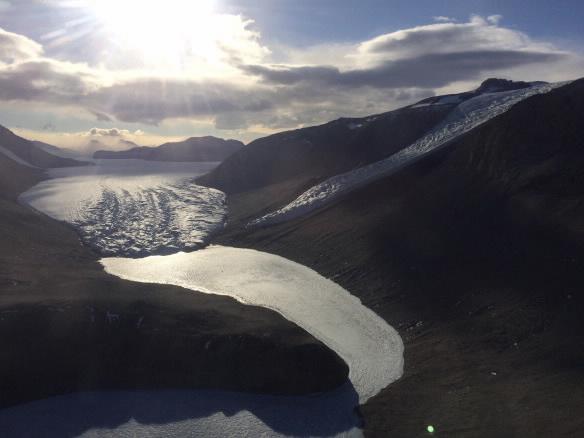

Published on the 1st December 2015 by ANSTO Staff
 |
| Terminus of Taylor Glacier as seen from the helicopter. Photo by Peter Neff. |
The researchers want to understand how the potent greenhouse gas methane has changed in past times, using radiocarbon (14C) as a ‘tracer’ to discriminate between ‘fossil sources’, which are depleted in 14C, from ‘biogenic sources’, which have a 14C/12C ratio in equilibrium with the atmosphere of the time.
“We are looking at two main events that have occurred since the last glacial maximum (LGM) when atmospheric methane levels dramatically increased in a very short time at 13,700 and 11,550 Before Present (BP). This is important because there are two very large sources of fossil methane around today: the permafrost in the northern hemisphere and methane clathrate reserves around the margins of the continents. We don’t really understand how stable they are and they do have the potential to release vast quantities of methane into the atmosphere, amplifying the global warming already underway,” explained Smith.
The research will provide a better understanding of how these reserves will behave in a future warming world by seeing how they have behaved in the past.
The basic idea is to extract ancient air from the ice then to extract the methane from the air. The carbon in the methane is then converted into graphite, loaded into a target, and measured for 14C using the technique of accelerator mass spectrometry (AMS) on the Antares accelerator in ANSTO’s new Centre for Accelerator Science (CAS).
 |
| Photo from a previous expedition to Antarctica to collect ice cores |
It sounds straightforward but there are complications. “Even with the atom-counting technique of AMS about 100 litres (L) of air is required to make a large enough target that contains about 20 micrograms of carbon,” said Smith.
“We can make such measurements at ANSTO, but how do you get 100 L of 14,000 year old air? Since ice contains about 0.1 L of air per kg of ice, 1 tonne of ice is needed for just one sample and that can’t be brought to the surface from depth using conventional ice drills.”
“We are going to Taylor Glacier which has been painstakingly surveyed over the last few years because the glacial ice fell as snow on Taylor Dome thousands of years ago. By measuring the composition of gases in the ice and by using the measured and modelled flow of the glacier, it is possible to find such large quantities of old ice near the surface today—as it moves towards the margins of the continent on its way to becoming icebergs.”
“As you walk along the glacier you are effectively walking back in time. With the 25 cm diameter Blue Ice Drill developed for this project, we will take multiple shallow cores that will be matched, trimmed and melted on site to liberate the air samples. Carbon dioxide is separated from smaller amounts of ice using a special sublimation system in the field. The air will be shipped to the University of Rochester in cylinders where carbon monoxide (CO) and methane (CH4) will be separated. Ultimately the samples come back to ANSTO as a minute quantity of carbon dioxide in a sealed glass tube.”
14C is produced in the atmosphere by cosmic radiation. When counting the 14C atoms in the CO, CO2 and CH4 samples, the researchers must also consider 14C production in the ice itself.
“Since falling as snow and being compressed into ice, the water (H2O) molecules in the ice have themselves been irradiated by cosmic radiation which produces 14C from the oxygen atoms in the water. Towards the end of the ice’s journey it is pushed towards the surface and sublimes away to water vapour, exposing the ice to more cosmic radiation,” said Smith.
 |
| Andrew Smith |
This is the second major objective of the project: to understand the production of 14C along the entire transit of the ice, to know how it is partitioned into the different gases and whether these gases are retained or vented from the ice.
“Without this knowledge it is impossible to read the subtle signals revealed by the radiocarbon activity of methane in the ice,” said Smith.
“We also have to allow for production in the air cylinders when we fly them half way round the world at high altitudes where the cosmic ray flux is large.”
Smith will fly with the US Air Force from Christchurch to the ice runway on the Ross Ice Shelf at the US base McMurdo Station. After a few days of training and briefing and a 45 minute helicopter flight, he will join the field party in their tent camp on the glacier, where he will spend Christmas and welcome in the New Year.
Andrew will return to ANSTO with two postdoctoral students from the University of Rochester, who will work in ANSTO’s Radiocarbon Lab and CAS for the next couple of months on their samples before returning to the USA.
University of Rochester projetc blog